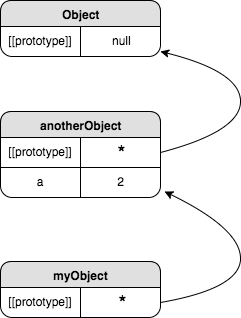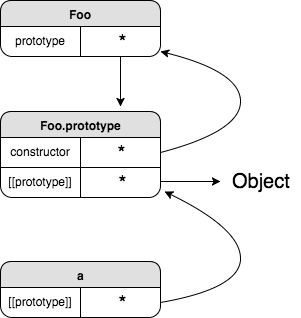프로토타입 (Prototype)
[[Prototype]]
- 명세에 따르면 자바스크립트 객체는 [[Prototype]]이라는 내부 프로퍼티가 있고 다른 객체를 참조하는 단순 레퍼런스로 사용한다.
var anotherObject = {
a: 2
};
// 'anotherObject'에 연결된 객체를 생성한다.
var myObject = Object.create(anotherObject);
myObject.a // 2;

- myObject는 anotherObject와 [[Prototype]]이 링크됐다.
- myObject.a란 프로퍼티는 없지만 anoterhObject에서 2라는 값을 대신 찾아 프로퍼티 접근의 결과값으로 반환한다.
- 만약, anotherObject에서도 못 찾으면 [[Prototype]] 연쇄를 다시 따라 올라간다.
- 연쇄 끝에 이르러서도 프로퍼티가 발견되지 않으면 [[Get]]은 결과값으로 undefined를 반환한다.
Object.prototype
- [[Prototype]] 연쇄가 끝나는 지점은 내장 프로토타입 Object.prototype에서 끝난다.
프로퍼티 세팅과 가려짐(shadowing)
var anotherObject = {
a: 2
};
var myObject = Object.create(anotherObject);
anotherObject.a; // 2
myObject.a; // 2
anotherObject.hasOwnProperty("a"); // true
myObject.hasOwnProperty("a"); // false
myObject.a++; // shadowing
anotherObject.a; // 2
myObject.a; // 3
myObject.hasOwnProperty("a"); // true
- 겉보기엔 myObject.a++가 anotherObject.a 프로퍼티를 찾아 1만큼 값을 증가시킬 것 같지만 ++ 연산자는 결국 myObject.a = myObject.a + 1을 의미한다.
- 따라서 [[Prototype]]을 경유하여 [[Get]]을 먼저 찾고 anotherObject.a에서 현재 값 2를 얻은 뒤 1만큼 증가시킨 후, 그 결과값 3을 다시 [[Put]]으로 myObject에 새로운 가려짐 프로퍼티 a를 생성한 뒤 할당한다.
클래스 함수
function Foo() {
// something
}
Foo.prototype; // {}
var a = new Foo();
Object.getPrototypeOf(a) === Foo.prototype; // true
- new Foo()로 새 객체 a가 만들어지고, 이 객체는 Foo.prototype 객체와 내부적으로 [[Prototype]]과 연결이 맺어진다.
생성자
function Foo() {
// something
}
Foo.prototype.constructor === Foo; //true
var a = new Foo();
a.consturctor === Foo; //true

- Foo.prototype 객체에는 기본적으로 공용 프로퍼티 constructor가 세팅되는데, 이는 객체 생성과 관련된 함수(Foo)를 다시 참조하기 위한 레퍼런스다.
function Foo() { /* */ }
Foo.prototype = { /**/ }; // 새 프로토타입 객체를 생성한다.
var a = new Foo();
a.constructor === Foo; //false
a.constructor === Object; //true
- 결론적으로 a.constructor 같은 임의의 객체 프로퍼티는 실제로 기본 함수를 참조하는 레퍼런스라는 보장이 전혀 없다.
- 이를 통해 객체간의 상속을 만들 수 있다. (프로토타입 상속)